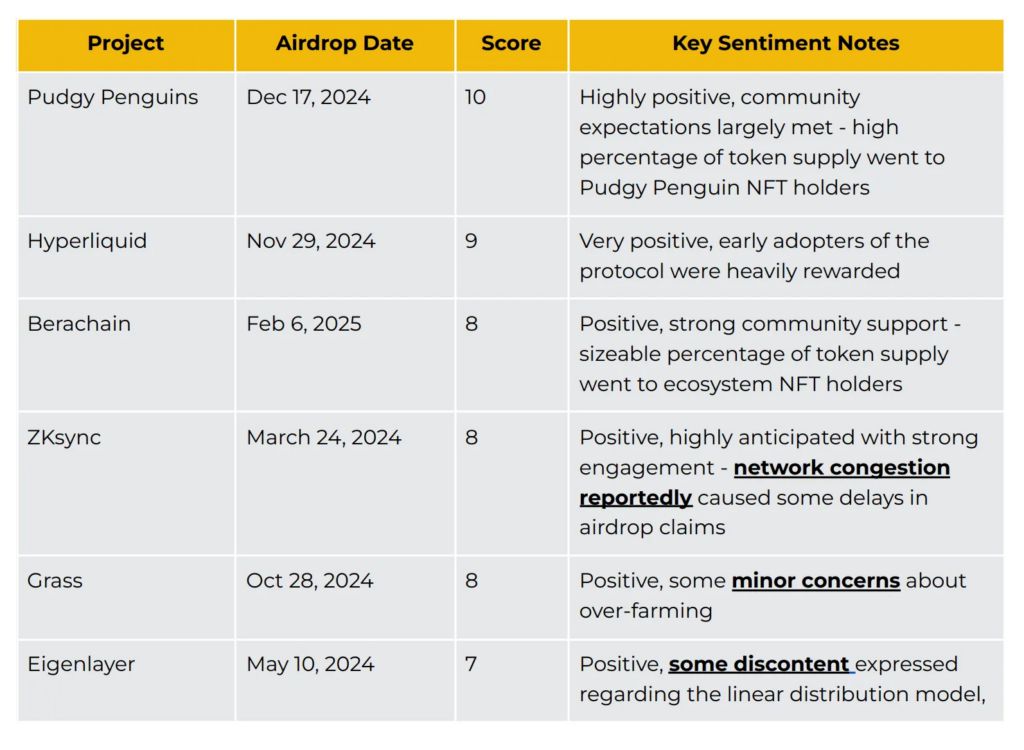Crypto Airdrops Are Broken: Binance Report Highlights Key Issues
Binance Research identifies fundamental problems with current airdrop practices. Report categorizes airdrops into “Retroactive” and “Engagement” distribution models. Community sentiment analysis reveals which projects delivered successful airdrops.
Airdrops have become one of the most widely used methods for token distribution in the cryptocurrency industry, but they are “certainly not without certain issues,” according to a new report by Binance Research.
The report identifies two primary types of airdrops: Retroactive Airdrops that reward users for past actions without prior notification, and Engagement Airdrops that announce qualifying actions in advance to attract new users.
Using sentiment analysis conducted with X’s Grok AI, the report evaluates crypto community reactions to recent airdrops.
Major Failures Include Last-Minute Changes and Unclear Eligibility
The Binance Research report identifies several common mistakes that have damaged community trust in airdrops.
One of the most problematic practices is reducing community token allocations shortly before distribution.
The report cites Redstone’s March 2025 airdrop as an example, where the team cut the community allocation from 9.5% to 5% at the last minute, triggering “significant community backlash.” It further notes,
“Last minute changes to token allocations may result in discontent amongst a project’s community. They may also signal a lack of thought and planning, which could undermine the community’s trust in the project team.”
Another recurring issue involves unclear eligibility criteria that lead to “uneven rewards that don’t necessarily reflect user activity.”
The report points to Scroll’s October 2024 airdrop, which distributed 7% of its total supply but faced criticism for “arbitrary snapshot and hidden rules.”
Insider-heavy distributions also received criticism, with Kaito’s February 2025 airdrop highlighted for allocating 43.3% to team/investors and only 10% to the community.
The report also notes concerns about large allocations to influencers who “may choose to sell immediately, diluting the value for genuine users.”
Sentiment Analysis Reveals Most Successful Airdrop Strategies
To assess which airdrops resonated best with communities, Binance Research collaborated with X’s Grok AI to analyze social media feedback on notable token distributions from the past year.
The resulting sentiment scores, ranging from 1-10, provide insights into what factors contribute to positive community reception.
Pudgy Penguins achieved the highest sentiment score (10) for its December 2024 airdrop.
The report also noted that “community expectations were largely met” and a “high percentage of token supply went to Pudgy Penguin NFT holders.”
Hyperliquid followed closely with a score of 9, praised for its approach of heavily rewarding “early adopters of the protocol.”
 Source: Binance
Source: Binance
Other well-received airdrops included Berachain (8), ZKsync (8), and Grass (8), with common factors being strong community support, clear allocation rules, and appropriate rewards for early ecosystem participants.
In contrast, projects with the lowest sentiment scores included Redstone (2) and Scroll (3), with criticisms focusing on last-minute allocation changes and perceptions of excessive airdrop farming.
Recommendations For Improving Future Token Distributions
Binance Research offers three primary recommendations for projects trying to improve their airdrop processes.
One is increasing focus and transparency, improving community involvement, and implementing better monitoring tools to prevent exploitation.
For transparency improvements, the report distinguishes between approaches suitable for different airdrop types.
With Retroactive Airdrops, projects should “ensure distribution metrics are clearly communicated to user bases before airdrops are made claimable” and maintain continuous communication to align community expectations with project goals.
For Engagement Airdrops, the recommendation is to “provide airdrop distribution metrics as clearly as possible” and “avoid making changes once publicly published.”
The report acknowledges the growing threat of “sybil farming” where users create multiple accounts to maximize airdrop rewards.
It cites projects like LayerZero that have worked with on-chain analytics firms to identify and disqualify farmers from receiving tokens.
Looking toward the future, Binance Research expresses optimism that as monitoring tools improve and become more widely available, “unwanted airdrop farming activity should trend to zero.”
Disclaimer: The content of this article solely reflects the author's opinion and does not represent the platform in any capacity. This article is not intended to serve as a reference for making investment decisions.
You may also like
Buyer Battles Begin as BlockDAG Offers 25M BDAG Daily! LINK Price Prediction Leans Toward $25 & TRX Crypto Shows Strength
Catch the next big crypto as LINK price prediction targets $25, TRX crypto shows strength & BlockDAG drops Buyer Battles offering 25M BDAG daily fueling buying frenzy.Chainlink Price Prediction Targets $25 BreakoutTRX Crypto Draws Volume After USDT Mint & ETF HypeBlockDAG Launches Daily Buyer BattlesStrong Moves Are Happening Live

Digital Commodity Capital Adds XRP to Its Portfolio, Bolstering Institutional Interest
BlockDAG Drops Price Pre-Reveal as Fartcoin Gains Traction

XRP Price Target Debated; SHIB Burns and Unstaked Gains

